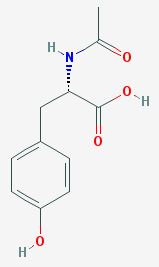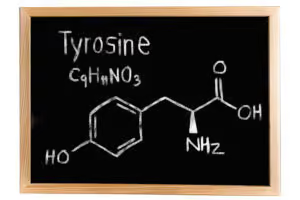Table of Contents
N-Acetyl L-Tyrosine (NALT or NAT) is a highly bio-available form of the amino acid L-Tyrosine. Your brain uses the enzyme tyrosine hydroxylase to convert L-Tyrosine into L-DOPA. Decarboxylation of L-DOPA results in synthesis of the neurotransmitter dopamine.[i]
Once converted into dopamine, the enzyme dopamine-beta-hydroxylase converts it into the neurotransmitters norepinephrine (noradrenaline) and epinephrine (adrenaline). This triad of neurotransmitters are collectively referred to as “catecholamines”.
N-Acetyl L-Tyrosine can be a highly effective nootropic for boosting cognitive function. And is particularly helpful in maintaining cognitive performance when you’re under practically any kind of stress. Including music played above 90 dB’s.
N-Acetyl L-Tyrosine works in synergy with stimulants like methylphenidate (i.e. Ritalin).[ii] Drugs like Ritalin work by blocking the reuptake of the neurotransmitters dopamine, and norepinephrine. And if there’s not enough dopamine available to do the job, Ritalin doesn’t work very well. NALT potentiates increases in extracellular dopamine.
NALT also stimulates the production of thyroid hormones T3 (triiodothyronine) and T4 (thyroxine) which are crucial in maintaining both overall physical and cognitive health.
NALT can boost libido, memory, focus, concentration, mood, offers anti-depressant effects, and improves executive function in those with ADHD.
N-Acetyl L-Tyrosine helps:
- Cognitive Stress. NALT produces the catecholamine-triad of neurotransmitters dopamine, norepinephrine and epinephrine. Sleep deprivation and extreme stressors like heat and cold can deplete catecholamine levels. NALT restores them to preserve optimal cognition.[iii]
- Neurotransmitters. NALT is a necessary precursor for dopamine, norepinephrine and epinephrine. As your dopamine levels increase, you’re better able to concentrate, organize your thoughts, and stay productive.
- Attention Deficit Disorder (ADHD). NALT can be an effective treatment for ADHD symptoms. NALT works in synergy with pharmaceutical drugs like Ritalin and Adderall by boosting extracellular levels of dopamine. Helping these drugs be more effective. And mitigating side effects like crashes when the drug wears off.
Overview
N-Acetyl L-Tyrosine (NALT) is a form of the amino acid L-Tyrosine. The addition of an acetyl group to L-Tyrosine makes it more bioavailable than supplementing with L-Tyrosine.

Your brain converts L-Tyrosine to L-DOPA which then produces the neurotransmitter dopamine. The unused dopamine is then further converted into the neurotransmitters norepinephrine (noradrenaline) and epinephrine (adrenaline). This triad of neurotransmitters are collectively referred to as “catecholamines”.
“Tyrosine” is derived from the Greek word tyros, meaning cheese. It was first discovered by German chemist Justus von Liebig in 1846 in the protein casein from cheese.
Tyrosine is considered a non-essential amino acid because it can be synthesized in your body from phenylalanine. Which is found in many high-protein foods such as poultry, fish, dairy, nuts, soy products, lima beans, avocados and bananas.
NALT enhances working memory and executive function in the prefrontal cortex. It helps with creative flow states, is fuel for inspiration, cognitive flexibility, and the kind of “convergent thinking” you do in multiple choice exams.
N-Acetyl L-Tyrosine assists in the production of thyroid hormones T3 (triiodothyronine) and T4 (thyroxine) which are crucial in maintaining both overall physical and cognitive health.
N-Acetyl L-Tyrosine (NALT) vs. L-Tyrosine: What’s the Difference?
 N-Acetyl L-Tyrosine (NALT) is the amino acid L-Tyrosine with an acetyl group added. When you take NALT as a supplement, it breaks down in your kidneys back into L-Tyrosine. So in theory, the two supplements offer the same benefits.
N-Acetyl L-Tyrosine (NALT) is the amino acid L-Tyrosine with an acetyl group added. When you take NALT as a supplement, it breaks down in your kidneys back into L-Tyrosine. So in theory, the two supplements offer the same benefits.
There is some debate in the nootropics community on which is more effective. NALT or plain L-Tyrosine. NALT is a more soluble form of L-Tyrosine so it should be more bioavailable to your body.
However, some studies report that in some cases, a sizeable percentage of supplemental NALT is excreted in urine before it’s converted into L-Tyrosine.[iv]
On a personal note, I haven’t had any issues using NALT as a source of L-Tyrosine. It gives me a dopamine and adrenal boost you’d expect from supplementing with a dopamine precursor.
When dealing with ADHD/ADD it’s particularly effective when stacked with ALCAR (Acetyl-L-Carnitine). ALCAR easily crosses the blood-brain barrier for boosting acetylcholine levels. And seems to positively influence serotonin levels. And NALT provides my brain with the dopamine it needs to mitigate symptoms of ADHD/ADD.
But in the interests of full transparency, this is stacked with 20 mg of Ritalin twice a day. Clearly, my brain doesn’t have the capacity to produce enough dopamine on its own. And needs the boost that comes from supplementing with NALT.
So like all nootropics, YMMV. Always take into account how each nootropic works synergistically with others in your stack. And how they work with any meds you need to take.
This is as much art as it is science. And experimentation is key for optimal cognition, and a ‘Limitless’ mindset.
How does N-Acetyl L-Tyrosine work in the Brain?
N-Acetyl L-Tyrosine boosts brain health and function in several ways. But two in particular stand out.
- N-Acetyl L-Tyrosine improves memory and cognition under acute stress. Acute stress is defined as short-term stressors that can affect cognition. Examples are extreme heat or cold. Things like cold showers, extreme sports, car accidents, relationship problems, intense movies, business deals gone awry, exams and war zones.
In one study done at the University of Bedfordshire in the UK, the effect of L-Tyrosine on cognitive performance was measured before an exercise task.
Researchers recruited 8 soccer players. And had them complete a 90-minute soccer simulation performance test in an environmental chamber set at 77 degrees Fahrenheit.
The soccer players were given either L-Tyrosine before exercise or a placebo. Cognitive performance was measured before the exercise task. Then again at “half-time”, following half time, and following the entire simulation.
The cognitive performance task assessed dual-task and vigilance. The outcome revealed that cognitive vigilance and reaction time among soccer players significantly improved following administration of L-Tyrosine.
Results showed that in warm-weather conditions, L-Tyrosine could enhance cognitive function and prevent cognitive impairment during exposure to exercise-heat stress.[v]
- N-Acetyl L-Tyrosine boosts neurotransmitters. NALT turns into L-Tyrosine once taken as a supplement. It then converts into the neurotransmitter dopamine. Dopamine is used to control movement in your body, is fundamental to memory, attention and problem solving.
The unused dopamine can then convert into the neurotransmitters norepinephrine (noradrenaline) and epinephrine (adrenaline).
Norepinephrine is important for attentiveness, emotions, sleeping, dreaming and learning.
Epinephrine drives your ‘flight-or-flight’ response. It’s what prompts your reaction to dangerous circumstances, emergency situations, or in stressful situations or environments.
In one study done in the Netherlands, researchers determined if L-Tyrosine would boost cognitive resources associated with cognitive control. They performed tests designed to measure “working memory” using the N-Back Test.
Study participants were assigned to engage in a “1-back” condition of easy difficulty and then a 2-back condition of tougher difficulty. Those that used L-Tyrosine demonstrated superior performance in the 2-back test, but not the 1-back test.
The study authors suggested that L-Tyrosine provides greater cognitive enhancement when cognitive demand increases. The bottom-line; supplementation of L-Tyrosine may help you increase your IQ score due to maximizing catecholamine reserves.[vi]
How things go bad:
As we get older, our brain and body chemistry and energy metabolism changes.
↓ Dopaminergic neurons are damaged or die
↓ Neurotransmitter levels decline
↓ Thyroid hormones decline
↑ Stress levels increase
↓ Working memory and mood decline
All of these changes are often attributed to aging. But could be a result of dietary and lifestyle choices. Unchecked, they could lead to neurodegenerative diseases like Parkinson’s, a drop in quality of life and depression.
N-Acetyl L-Tyrosine benefits
N-Acetyl L-Tyrosine (NALT) can boost levels of the neurotransmitters dopamine, norepinephrine and epinephrine. And can help a sluggish thyroid produce more T4 and T3.
 NALT can help boost cognition especially in stressful situations. It helps improve decision making, ‘flow state’ and creativity, cognitive flexibility, and working memory.
NALT can help boost cognition especially in stressful situations. It helps improve decision making, ‘flow state’ and creativity, cognitive flexibility, and working memory.
NALT converts into L-Tyrosine which then converts into L-DOPA to produce dopamine. L-DOPA is also used to make melanin in your body. This conversion process helps in the removal of neurotoxic quinones. And chelates heavy metals like mercury and lead which can accumulate in and damage neurons.
The dopamine that is not used by your brain is available to produce norepinephrine (noradrenaline) which is important for attentiveness, emotions, sleeping, dreaming and learning.
NALT can be an effective nootropic when stacked with ADHD/ADD meds like Ritalin or Adderall. It helps supply extracellular dopamine needed to improve the effectiveness of stimulants used to boost the uptake of dopamine in your brain.
How does N-Acetyl L-Tyrosine feel?
Keep in mind that NALT is a precursor to catecholamines. So if you’re not ‘low’ on dopamine, norepinephrine or epinephrine – you may not ‘feel’ anything.
Many neurohackers report a lift in mood, better focus, concentration, increased energy, and an overall sense of well-being. NALT can help re-adjust your motivation levels. It can help lower anxiety levels, especially social anxiety.
Supplementing with N-Acetyl L-Tyrosine can help bring your blood pressure down if it’s elevated from a stressful situation or environment. Take it before the stressful event if you can.
NALT helps buffer the effects of stimulants like caffeine or amphetamines. It helps potentiate and prolong the effects of Ritalin or Adderall, and reduces the crash.
If you’re into athletics or do manual work, you’ll find that supplementing with NALT before a workout or construction job will leave you feeling great afterwards. It helps mitigate many of the effects of acute stress caused by short-term stressors.
And NALT helps your body to produce melanin, so you may find it easier to get a tan while at the beach.
N-Acetyl L-Tyrosine Clinical Research
N-Acetyl L-Tyrosine to treat ADHD
Several studies have investigated using L-Tyrosine for the treatment of ADHD. One informal study published in the 1980’s determined that L-Tyrosine resulted in short-term relief from ADHD symptoms. But subjects eventually reached tolerance and a diminished effect.
This is important for neurohackers to keep in mind. It seems that NALT on its own can benefit some more than others. Regardless if your treating ADHD, or are perfectly cognitively healthy.
I’ve seen more than one report of nootropic users experiencing tolerance after just a week of supplementing with NALT. But most peer-reviewed, published studies show positive results.
One study published in Neuropsychiatric Disease and Treatment in 2011 looked at using amino acid precursors for the treatment of ADHD. Including L-Tyrosine for dopamine, and 5-HTP for serotonin.
The study used 85 young people aged 4 – 18 years old, all with a clinical diagnosis of ADHD. They were treated for an initial period of 8 – 10 weeks. Urinary samples to determine serotonin and dopamine levels were collected within the first 4 weeks. If they didn’t reach adequate levels, subjects were moved to higher dosing levels 2 and then 3 until they got relief from symptoms.
Researchers found that the dopamine and serotonin precursors yielded similar results to Strattera and Ritalin. And “the amino acid protocol may be equal in efficacy to potent, pharmaceutical ADHD medications”.[vii]
L-Tyrosine reduces blood pressure under stress
This study is particularly interesting for its nootropic application. It’s commonly understood that blood pressure rises when we’re under stress. The source of stress doesn’t really matter. Stress up = blood pressure up.
A study in Amsterdam showed that L-Tyrosine administration decreased blood pressure about 15 minutes after ingestion. This study involved assessing task performance following acute stress.
Acute stress is usually short-term and can be caused by driving, fighting, athletics, martial arts training, war, combat training, Crossfit, cold showers, loud music, intense movies, loud noises, business deals, relationships, school, exams and more.
The point is, this study is applicable to every one of us. The study found that L-Tyrosine reduced diastolic blood pressure within 15 minutes of taking the supplement. And blood pressure normalized within 1 hour.
This study tells us that L-Tyrosine (and NALT) may promote a decrease in blood pressure caused by stress. And could be used to mitigate the effects of stressful situations if taken prior to the stressful event.[viii]
N-Acetyl L-Tyrosine promotes cognitive flexibility
Cognitive flexibility applies to those who can adjust their thinking quickly to adapt to novel situations and stimuli. A high degree of cognitive flexibility is associated with increased fluid intelligence, superior reading and comprehension, and a healthier brain.
Recent research (2015) supports the idea that L-Tyrosine (and NALT) promotes cognitive flexibility. In this trial, researchers recruited 22 adults. And setup a double-blind, placebo-controlled study.
All subjects were assigned a task switching procedure to measure their flexibility. The results showed that receiving L-Tyrosine supplements increased cognitive flexibility compared to the placebo group. The researchers determined that “L-Tyrosine can facilitate cognitive flexibility by repleting cognitive resources”.[ix]
The team observed that increased cognitive flexibility was likely due to a boost in dopamine concentrations. They noted that L-Tyrosine enhanced usage of various cognitive resources. And one way to increase your cognitive flexibility would be to start supplementing with N-Acetyl L-Tyrosine.
It stands to reason that people who are close-minded, set it their ways, are resistant to change and can’t cope with unexpected stimuli or situations have “cognitive rigidity”. And it’s likely due to suboptimal dopamine levels.
N-Acetyl L-Tyrosine Dosage
N-Acetyl L-Tyrosine (NALT) suggested dosage for cognitive benefit is 350 – 500 mg twice per day.
NALT is water-soluble so you don’t have to take it “with a meal” or healthy fat like some nootropics.
You may find your body responds to smaller doses. Or even more if you are stacking it with stimulants like ADHD meds. Listen to your body and see how you react.
N-Acetyl L-Tyrosine Side Effects
NALT quickly turns into the non-essential amino acid L-Tyrosine once you take it. So is considered non-toxic and very safe. Most neurohackers don’t have any negative side effects.
At higher doses there are reports of stomach issues and migraines. Migraine problems usually happen to those who already suffer from migraines. This may be an indication that your neurotransmitter levels are already optimal and you don’t need to supplement with NALT.
NALT can increase your thyroid hormones. So if you’re hyperthyroid you shouldn’t use NALT.
And if you’re taking MAO inhibitors (MAOI’s) like selegiline, Azilect, Marplan or Nardil you should not use NALT. MAOI’s work in your brain and effect neurotransmitters. So using NALT in combination with MAOI’s could throw off the delicate balance of neurotransmitters needed for optimal brain health and cognition.
Where to buy N-Acetyl L-Tyrosine
N-Acetyl L-Tyrosine is available in powder, capsule and tablet form. Capsules and tablets are usually 300 – 500 mg.
Some pre-made nootropic stacks and workout stacks also include NALT as part of their formula. For example, Click for Mind Lab Pro® contains 11 brain enhancing nootropic compounds including N-Acetyl L-Tyrosine.
I recommend Mind Lab Pro because it addresses all aspects of anxiety resistance, memory and cognitive enhancement, stabilizes mood, brain repair, and maintenance.
This premium nootropic stack is designed to affect neurotransmitters, cognitive energy, brain waves, neuroprotection, and regeneration. See my Mind Lab Pro review for a detailed report.
Ensure you read labels carefully, and stick with manufacturers who follow Good Manufacturing Practices (GMP). And are GMP-Certified.
Nootropics Expert Recommendation
N-Acetyl L-Tyrosine (NALT) 350 – 500 mg twice per day
 I recommend using N-Acetyl L-Tyrosine (NALT) as a nootropic supplement.
I recommend using N-Acetyl L-Tyrosine (NALT) as a nootropic supplement.
Your body does synthesize some L-Tyrosine from phenylalanine which comes from high-protein foods like chicken, fish, almonds, avocados and bananas.
But most of us don’t get enough L-Tyrosine from our diet. So supplementation will help. And N-Acetyl L-Tyrosine is a highly bioavailable form of L-Tyrosine. So you should feel its effects faster.
NALT is helpful for most neurohackers to combat stress and sleep deprivation. It’ll boost dopamine, norepinephrine and epinephrine levels.
It’s particularly helpful if you take NALT prior to a stressful situation, workout or physically demanding job.
NALT is especially helpful to those dealing with ADHD/ADD. It’s a great compliment to stack with stimulant meds like Ritalin or Adderall. NALT will provide the dopamine your brain needs. It will help smooth out and prolong the effects of stimulant meds. And help prevent the associated crash when they wear off.
A good stack for ADHD is using your usual med dose with NALT 500 mg and ALCAR 500 mg.
You can buy individual N-Acetyl-L-Tyrosine supplements. Or you could try my favorite pre-formulated nootropic stack Click for Mind Lab Pro® which includes NALT.
Mind Lab Pro contains a synergistic blend of 11 brain enhancing nootropics covering all aspects of cognition and brain health. See my full Mind Lab Pro review for more.
You can safely use up to 1,500 mg per day when stacking with ADHD meds. But dosed throughout your day.








Join The Discussion - 203 comments
Tiago
September 1, 2020
Do you ever tried vyvanse? Do you think ritalin is better than it? And what about Concerta and Ritalin LA, is ritalin better? Should I take ritalin along with nalt and alcar?
David Tomen
September 1, 2020
Tiago, I’ve never tried Vyvanse but I did use Adderall for about 6 months. And switched back to Ritalin. Because Adderall didn’t work for me.
There is no “better” stimulant. Only the one that works best for you. Each one has a different mechanism of action. This is how Vyvanse works in your brain: https://en.wikipedia.org/wiki/Lisdexamfetamine#Pharmacology.
You can use Wikipedia to look up each of the others as well to compare how each works in the human brain. If Vyvanse works for you then I suggest using the supporting nootropics with it as I describe in this post: https://nootropicsexpert.com/best-nootropics-for-adhd-add/. There’s no benefit to switching to Ritalin.
Adrian
August 6, 2020
Hi David,
I have been experimenting with Aniracetam and Noopept (not at the same time) in combination with alpha-GPC to increase my attention, however, they both seem to increase my brain fog and substantially lower my motivation. I tried to vary with the amount of both alpha GPC and Aniracetam/Noopept but this didn’t improve the side effects. Could this have happened because of inadequate levels of dopamine? Since both Aniracetam and Noopept affect dopamine.
I’m therefore considering to take NAC to repair dopamine neurons and receptors and NALT to slightly increase dopamine levels to see whether my brain fog improves together with my motivation. My only concern is that I use effexor (low dosage) which is also a norepinephrine reuptake inhibitor. Can I use NALT or would that be too dangerous?
Thanks!
David Tomen
August 6, 2020
Adrian, sounds like you are experiencing the side effects of Effexor. Just be careful about using NALT or L-Tyrosine with this drug. NAC may help repair dopamine receptors so is a good choice.
Val
July 6, 2020
Hello David, thank you for your excellent work at the blog. I have a question regarding dosing for L-tyrosine (as I only found dosing recommendations for NALT).
I’m struggling with adult ADD (in my 40s) that affects my ability to initiate action, plan and get a general overview of my life. I tried concerta for a few a years but stopped taking it 5 years ago (along with Sertralin), because it had stopped working, and, unfortunately, left me in a state of anhedonia, with lower levels of enthusiasm, and considerably less spontaneous, innovative and creative — which handicapped my creative writing. I’m trying to break the deadlock by becoming enough motivated (executive functioning) while simultaneously recover my creative elan (from younger years). I suspect my dopamine receptors might have been downregulated, or damaged.
I’m presently (since may) trying ALCAR (1g), L-tyrosine (650mg) , b-complex, c-vitamin, ashwagandha (1g), Bacopa Monnieri (700mg), q10, fish oil 950dha, coconut oil. All of which is working to lift my brain sluggishness, but I haven’t yet reached a state of necessary motivation. I’ve read your post on motivation but I live in a country where racetams are hard to get by. So I’m wondering if I need to raise the dosage of L-tyrosine.
I’ve also a question about your thoughts about Pregnenolone.
Best regards, Val
David Tomen
July 6, 2020
Val, have you seen my post on motivation here: https://nootropicsexpert.com/hacking-motivation-with-nootropics/. You need to activate AMPA receptors. That’s the missing link. And if you can’t get racetams your only other option is Resveratrol and/or Rhodiola Rosea.
Val
July 10, 2020
Thanks, I’ll try that.
sandro
June 6, 2020
Hi David! my doctor said i have my norepinephrine very high! which nootropic could i use to help me? I have difficulty slowing down, running mind, irritation, etc …
I would appreciate your help …
thankful,
Sandro
David Tomen
June 7, 2020
Sandro, norepinephrine is made from dopamine using the enzyme dopamine-beta-hydroxylase. One of the best ways to counter excess dopamine is to raise serotonin using L-Tryptophan.
Sunja George
May 19, 2020
Hi David,
Is it safe to take a combination of 5-htp (at night 100mg), Rhodiola (500mg) & L-tyrosine (500mg) daily?
I struggle with chronic anxiety, add & sometimes low mood.
I have been taking Rhodiola for a month now & while I do find it is effective, I find my concentration is still poor & need to supplement with caffeine.
Thank you for your great website.
Sunja
David Tomen
May 19, 2020
Sunja, it’s certainly safe. But you may find that eventually you won’t get the benefit from 5-HTP as much as you once did. If that happens switch to 500 mg L-Tryptophan which is also a direct precursor for the synthesis of serotonin and melatonin.
Also, pay attention to dosage instructions because for nootropics like L-Tyrosine the half-life is only a few hours. You’ll likely have better results dosing it at least twice per day – morning and noon.
And I suggest taking a look at the different mechanisms of action for caffeine. You are already supporting its use with L-Tyrosine. But you also need the B-Vitamins because caffeine depletes them. And it raises cortisol which you can reverse by using L-Theanine.
MOHAMMAD AZZANI
April 26, 2020
Does L_TYRROSIN useful in Parkinson’s and depression cases and what product you recommend and thank you very much?
David Tomen
April 26, 2020
Mohammad, L-Tyrosine may be useful in Parkinson’s. But Mucuna Pruriens extract (L-DOPA) at as high a strength % of L-DOPA you can get will likely be more effective. Because it’s much closer to levadopa which is prescribed to treat this disease but without the side effects.
This is the brand of L-Tyrosine I use: https://amzn.to/3cRhlVw. And I also get some from using Mind Lab Pro daily.
Mohammad alazzani
April 28, 2020
I appreciate your efforts
Steve
March 21, 2020
Hi David,
I want to know the differences between NALT and DLPA which are similar from what I’ve seen as well as interactions. I’ve taken DLPA for the first time today and found it a very positive experience. Now some people say if you take both DLPA and L Tyrosine (which I did today) has an even more long lasting effect. Would the same be true taking NALT and DLPA or all three together, do you have any experience of this?
David Tomen
March 21, 2020
Steve, this section of my phenylalanine review explains how it works: https://nootropicsexpert.com/phenylalanine/#l-phenylalanine-vs-d-phenylalanine-whats-the-difference. They are both precursors to the synthesis of dopamine. I’ve not tried using both and never found the need to try them together. I use L-Tyrosine or NALT daily.
Maicon
October 22, 2019
Does NALT Help Testosterone Production?
David Tomen
October 24, 2019
Maicon, some marketers are promoting L-Tyrosine and Mucuna Pruriens as a cure for ED and a testosterone booster. But the only evidence I was able to find one study (worldwide) with 75 infertile men in Lucknow, India.
The study concluded that supplementing with Mucuna Pruriens significantly improved Testosterone, Luteinizing Hormone, dopamine, adrenaline, and noradrenaline levels in infertile men and reduced levels of Folicle Stimulating Hormone and Prolactin. Didn’t say why or how much Mucuna: https://www.ncbi.nlm.nih.gov/pubmed/18973898
I’ve been using NALT and Mucuna for years and if it increased T in my body it wasn’t by a noticeable amount.